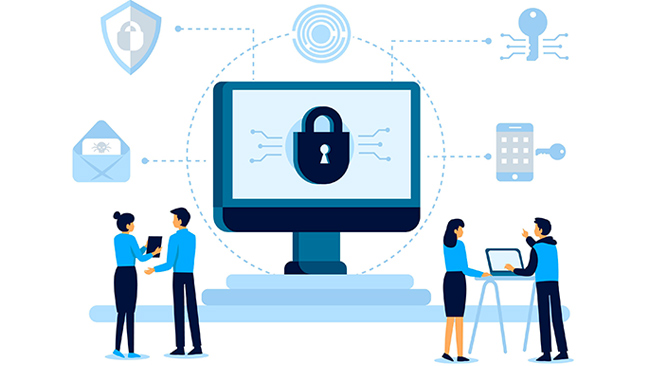If your business is yet to set up a comprehensive IT and cybersecurity strategy, now is the time to do so. A detailed plan will give you a competitive advantage and peace of mind knowing your business is protected against potential online threats.
In this post, we’ll cover many of the critical components of an IT and cybersecurity strategy and how you can learn more in information technology courses.
Benefits of Having an IT and Cybersecurity Strategy
First, let’s discuss the most profound benefits to your organization when you have information technology and cybersecurity strategy in place.
An IT and cybersecurity strategy will:
- Help you secure funding from investors, as they will see that you are serious about protecting your online assets. It will also help you get insurance coverage for your business.
- Protect your customer data and intellectual property from cyberattacks. This is becoming increasingly important as hackers target more businesses.
- Help you comply with industry regulations, such as the General Data Protection Regulation (GDPR) in the European Union or the Payment Card Industry Data Security Standard (PCI DSS), if you accept credit card payments.
- Give you a competitive edge against other businesses in your industry that have not yet implemented such a strategy.
- Allow you to make informed decisions about which cybersecurity products and services to invest in.
- Help you develop policies and procedures for dealing with data breaches and other cybersecurity incidents.
- Teach your employees about online security risks and how to avoid them.
As you can see, there are many benefits to having an IT and cybersecurity strategy. Now, let’s look at the key components of such a strategy.
What Your IT and Cybersecurity Strategy Should Include
Here are some of the most critical components of a comprehensive IT and cybersecurity strategy.
Employee Training
All employees should be trained in basic cybersecurity measures, such as how to spot phishing emails and protect their passwords. You might also want to consider offering more comprehensive cybersecurity training for employees who handle sensitive data regularly. Further, all employees should be aware of your company’s cybersecurity policy and procedures.
To ensure everyone is up to date and on the same page, consider conducting regular cybersecurity training sessions and audits. You can also promote a culture of security by offering rewards for employees who identify potential risks and report them immediately.
Network Security
Your IT and cybersecurity strategy should also include measures to protect your company’s network from attacks. This may involve installing firewall software, encrypting, and setting up access controls.
Data Security
In addition to protecting your network, you’ll also need to take steps to protect the data stored on your company’s servers and devices. This may involve encrypting data at rest and in transit and implementing security measures such as data loss prevention software.
Regular Updates
As new threats emerge, updating your IT and cybersecurity strategy regularly is essential. You can protect your business against the latest online threats by staying up to date. In addition, you can learn about new threats and how to protect against them by taking information technology courses.
Cyber Insurance
If a cyberattack hits your business, cyber insurance can help cover recovery costs. Your policy should include coverage for specific threats. When selecting a policy, be sure to work with an experienced broker who can help you find the ideal coverage.
Disaster Recovery
Finally, your IT and cybersecurity strategy should include a disaster recovery plan. This will ensure that you can quickly and easily recover from an attack or any other type of incident.
Your disaster recovery plan should include a backup of all critical data and a way to restore systems and applications during an outage.
Implementing an IT and Cybersecurity Strategy
Now that we’ve discussed the critical components of an IT and cybersecurity strategy let’s talk about how you can get started.
Follow these steps to implement your IT and cybersecurity strategy:
- First, determine your company’s cybersecurity needs. For example, you’ll need to decide which data types need to be protected and how much protection is required.
- Develop policies and procedures. Once you know your company’s cybersecurity needs, you can develop policies and procedures to address them. Be sure to involve all relevant stakeholders in this process.
- Choose the right products and services. Next, you’ll need to select the right mix of products and services based on your company’s needs to protect your business. This may include firewalls, intrusion detection systems, and anti-virus software.
- Train your employees. As we mentioned earlier, employee training is integral to any IT and cybersecurity strategy. Be sure to provide your employees with the resources they need to stay up-to-date on online threats and your company’s cybersecurity policies.
- Monitor and review. Finally, monitoring and reviewing your IT and cybersecurity strategy is essential. By doing so, you can ensure your business is protected against the latest online threats.
Following these tips can develop a comprehensive IT and cybersecurity strategy to give your business a competitive edge.
How to Learn More
When protecting your business, don’t wait until it’s too late. Instead, implement a comprehensive IT and cybersecurity strategy today. If you’re not sure where to start, consider taking information technology courses to learn more about how to protect your business against cyber-threats. Cybersecurity training will give you the tools you need to develop an effective strategy for your business.




Leave a comment
Have something to say about this article? Add your comment and start the discussion.